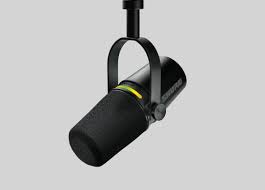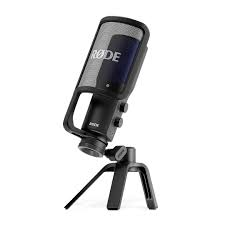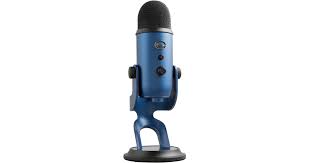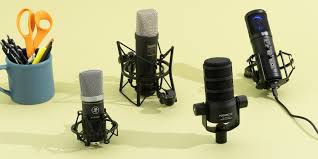Podcasts are popular as they let people share stories, ideas or chatting easily. A good USB microphone makes your voice clear and professional. The USB microphones connect directly to your computer – no additional equipment is required. The USB microphone is a top option for many podcasters due to its convenience, strength and decent sound performance. They are easy to use and are great for beginners or professionals who want quality sound without any problems.
Related: Best Microphones For Vocals
The best features of the best USB microphone for podcasting
sound
For any podcast, clear and sharp sound is needed. The microphone you chose should provide natural sound production and ensure that your voice is taken accurately. Look for a microphone that tackles the entire frequency range of human voice, usually between 20Hz and 20 kHz.
usability
USB is the most practical option for microphone podcasters. They provide plug-end-play functionality, which means they can be connected directly to your computer or laptop without any additional tools or complex setups. This usability is a beginner or ideal for those who need to be set quickly.
Tolerance
It is another factor to consider stability. The best microphones are completed, especially if you plan to use them often for long sessions. For microphones made of high quality metal or plastic or plastic, which are strong racks or mounts.
Noise reduction
Background noise can ruin the clarity of your podcast. Some USB microphones are equipped with noisy features, which helps to reduce unwanted sounds from the environment. These properties are especially important if you register in a noise room or home office.
Budget
USB microphones come in different price limits. While budget -friendly alternatives can still provide quality sound, premium microphones often provide additional functions, better sound loyalty and more flexibility. Find a microphone that fits your budget while meeting your podcasting needs.
Related: Best Bluetooth Microphones
4 best USB microphones for podcasting
1. SHUR MV7

Shure MV7 USB easily mixes professional sound. Podcasters choose this mike for its rich, warm sound that feels like radio quality. For decades, a brand, Shur, built this microphone to handle the home studio or layout on the go. This provides fast computer use for advanced equipment and USB for XLR. A free app allows you to make the sound level or patterns to twica, so it’s early-friendly and is deep enough for professionals. This Mike looks smooth in black and sits stable on the desk.
Specifications
| Feature | Details |
|---|---|
| Type | Dynamic |
| Connection | USB and XLR |
| Sound Pattern | Cardioid |
| Frequency Range | 50 Hz – 16 kHz |
| Headphone Jack | Yes, zero-latency |
| Weight | 1.21 lbs (550 g) |
| Extras | Shure Motiv app |
Why is this best USB microphone for podcasting?
Shure Mv7 Nail Broadcast-Taiyar Sound. The dynamic design blocks the noise in the room – such as air conditioning or nonsense – better than many microphones. The cardioid pattern is zero on your voice, works from the back. The app adds custom control as tone adjustment, so that you shape the sound to fit your style. The USB setup takes seconds and the headphone connector keeps you responsible for each word.
Pros
- Fantastic voting clarity
- Background bites noise
- Simple USB plug-in
- Dual USB/XLR User
- App Checking app control
Cons
- High price tags compared to budget mik
- Heavy than any options
2. Rode NT-USB

The root comes from the NT-assb rider, who is the same by the creators a sound name. This Mike gives Studio Sound at a reasonable price. This is a capacitor Mike, so it understands traveling the voice details – the perfect for the story or individual artists. Outside the box you get a rack rack, pop filter and USB cable. The silver black look gives style, and the layout is faster. Podcasters choose it to balance quality and price.
Specifications
| Feature | Details |
|---|---|
| Type | Condenser |
| Connection | USB |
| Sound Pattern | Cardioid |
| Frequency Range | 20 Hz – 20 kHz |
| Headphone Jack | Yes, zero-latency |
| Weight | 1.14 lbs (520 g) |
| Extras | Pop filter, stand |
Why is this best USB microphone for podcasting?
Rode NT-RUSB captures all vocal shades, thanks to the broad frequency range. The pop filter sounds stiff “P” or “B”, so the recording remains even. The headphone contact offers real -time listening, and the cardioed pattern focuses on you. No technical information is required for the setup plug it and the mail hits. It is a reliable choice for crisp, clean podcast.
Pros
- Excellent sound for cost
- Quickly and easily setup
- Stand and filters include
- Strong metal production
- Wide vocal area
Cons
- Some arms the noise in the room
- Tipi Desk is the room account
3. Audio-Technica ATR2100X-RUSB

Audio-technica ATR2100X-RUSB proves that you do not need a big rupee for good sound. This microphone keeps things lighter, portable and budget friendly. It uses a dynamic design to cut the noise and provides the USB Plus XLR port for flexibility. Podcasters catch it for home use or travel – it fits anywhere. The black finish looks smooth and contains a rack clip. It’s a solid start Mike done by you.
Specifications
| Feature | Details |
|---|---|
| Type | Dynamic |
| Connection | USB and XLR |
| Sound Pattern | Cardioid |
| Frequency Range | 50 Hz – 15 kHz |
| Headphone Jack | Yes, zero-latency |
| Weight | 0.59 lbs (268 g) |
| Extras | Stand clip, cables |
Why is this best USB microphone for podcasting?
This Mike distributes clear sound at a low price. The dynamic type prevents background noise, which is ideal for untreated rooms. Dual USB/XLR connection means it works now and later if you upgrade. The headphone connector puts you on the track, and its light weight fits podcasters moving around. For cost it turns over the class.
Pros
- Cheap but effective
- Decent sound quality
- Super portable
- USB and XLR ready
- Noise rejection
Cons
- Less depth than premium mix
- Usual, without frills design
4. Blue Yeti

Blue Yeti stands out as a podcasting legend. This Mike, created by the Loditech Blue brand, fits early and professionals. There is a capacitor Mike where four sound patterns – cardioed, stereo, ubiquitous and bilateral – so it handles any setup: solo, duty or group conversations. Fat design (silver, black or color) sits on an underlying stand. Podcasters easily love their versatility and plug-and-play usb.
Specifications
| Feature | Details |
|---|---|
| Type | Condenser |
| Connection | USB |
| Sound Pattern | Cardioid, Omni, Bidirectional, Stereo |
| Frequency Range | 20 Hz – 20 kHz |
| Headphone Jack | Yes, zero-latency |
| Weight | 3.2 lbs (1.45 kg) |
| Extras | Gain knob, mute button |
Why is this best USB microphone for podcasting?
Blue Yeti is beneficial for each podcast requirement. The four patterns cover a voice, two speakers or full-less chat. The sound is complete and clear in frequencies. Knots and cushioning provide immediate surplus control, and the headphone connector Audio lives live. It is a top choice for ease, strength and style in a package.
Pros
- Tones of pattern options
- Perfect for beginners
- Loud noise
- Built tripod and control
- Funny design options
Cons
- Raises the sound of room easily
- Big and heavy
Why should we choose it?
A Best USB microphone for podcasting changes your podcast game. These four PICs-Shure MV7, NT-RUSB, Audio-Technica ATR2100X-RUSB, and Blue Yeti-Offer Clear Sound, easy use and noise control. They fit small locations or home layouts, no pro -studio requires. You save cash since the mixer or interface is optional. Beginners seem easy to handle, and professionals get quality that rival large layouts.
Your voice is running your podcast. A solid Mike makes it pop, sticks to the audience and lifts the entire mood. Each alternative here corresponds to different requirements: Shur for Pro Sound, Rider for Value, Audio-Technique for Budget and Prity for Flexibility. Choose one that matches your style and wallet, and your episodes will be faster, clean and ready to share. Great sound draws people – these microphones do it!

